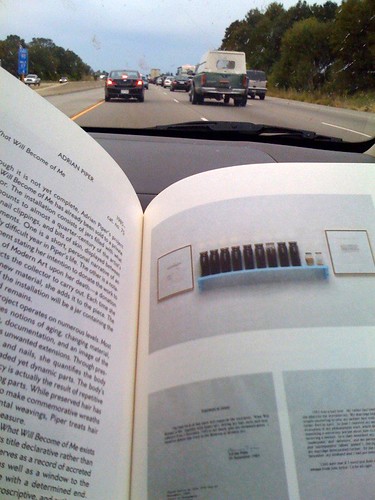
This weekend I took an eight hour journey from Chicago to Minneapolis for my first visit to the Walker Art Center and a chance to see some friends.
After an amazing night hanging out in my friend's backyard grilling burgers and playing with fire, we got up early and headed to the Walker Art Center. Being my first visit I wanted to experience the permanent collection before diving into the Quick & the Dead Exhibit. I was very excited to find a collection of props from many of Merce Cunningham's collaborations. Included were works done with Robert Rauschenberg, Jasper Johns, and Claus Oldenburg. Most of the pieces were sets pieces, props, or costumes. When seen through the lens of contemporary Fashion & Fiber Studies much of the work has become more important than the original dance pieces it accompanied.
The Walker's permanent collection is easily one of the best I've seen in a small museum. It consists mostly of work from the 1960's and forward which means no impressionist or early abstract paintings to waste valuable gallery space. In fact the collection was generally light on paintings which means they must have a contemporary-minded acquisitions committee.
I continued to be impressed when I entered the Quick & the Dead. Earlier this summer Tyler Green at Modern Art Notes posted a link to a rather bitchy/uninformed review of the show by a St. Cloud State University student (Let's hope this kid plans on becoming an actor or an American Idol). The student's sloppy walk through a deeply conceptual show only made me want to see it for myself. He wrote, "A motor spinning against the wall burning the rubber off of it into little particles collecting on the ground and I’m suppose to believe that that…that…THAT’S ART?!" The art in question was a 2006 piece by Michael Sailstorfer called, Zeit ist keine Autobahn - Berlin, (Time Is No Highway, Berlin). Saistorfer's piece perfectly captured much of the exhibit's zeal. With this work he managed to balance a sense of danger, while referencing disembodiment, and a sense of perpetual movement.
The show was extremely dense and gave me an opportunity to experience work from Steve McQueen (below), Adrian Piper (below), and Francis Alÿs (above) that I had never experienced in person. The 53 artists selected for the show use a vast range of media but are all conceptually similar. Each artist is trying in their own way to make sense of or attain the unattainable. This lofty goals lends itself to a lot of serious immersion with each piece.
Since much of the work was so engaging I will narrow my focus down to the highlights and spread this post over several days. As I mentioned Steve McQueen and Adrian Piper's work was compelling to see in person. McQueen's 11 minute film, Running Thunder, reminds viewers that death itself is can only be seen through a human lens and the still footage of a recently deceased horse remains peacefully far from gory. Wile Adrian Piper (one of the original make the private public artists) invites to MOMA to take possession of her ashes after her death as a final performance.


(Continued tomorrow)
No comments:
Post a Comment